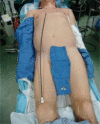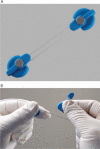Strategies for Transvenous Lead Extraction Procedures
- PMID: 32494448
- PMCID: PMC7252922
- DOI: 10.19102/icrm.2017.080502
Strategies for Transvenous Lead Extraction Procedures
Abstract
Transvenous lead extraction (TLE) has undergone an explosive evolution since its inception as a rudimentary skill with limited technology and therapeutic options. Early techniques involved simple manual traction that frequently proved ineffective for chronically implanted leads, and carried a significant risk of myocardial avulsion, tamponade, and death. The morbidity and mortality associated with these early extraction techniques limited their application to use only in life-threatening situations, such as infection and sepsis. The past four decades, however, have witnessed significant advances in lead extraction technology, resulting in more efficacious techniques and tools, providing the skilled extractor with a well-equipped armamentarium. With the development of the discipline, we have witnessed a growth in the community of TLE experts coincident with a marked decline in the incidence of procedure-related morbidity and mortality, with recent registries at high-volume centers reporting high success rates with exceedingly low complication rates. Future developments in lead extraction are likely to focus on new tools that will allow for us to provide comprehensive device management, develop alternative systems for extraction training, and focus on the design of new leads conceived to facilitate future extraction.
Keywords: Defibrillator; lead extraction; lead management; pacemaker.
Copyright: © 2017 Innovations in Cardiac Rhythm Management.
Conflict of interest statement
Dr. Epstein reports no relevant disclosures or financial arrangements. Dr. Maytin reports personal fees from Medtronic, Spectranetics, St. Jude Medical, and Biotronik, outside the scope of the submitted work.
Figures














References
-
- Pakarinen S, Oikarinen L, Toivonen L. Short-term implantation-related complications of cardiac rhythm management device therapy: a retrospective single-centre 1-year survey. Europace. 2010;12(1):103–108. [CrossRef] [PubMed] - DOI - PubMed
-
- Sridhar AR, Lavu M, Yarlagadda V, et al. Cardiac implantable electronic device-related infection and extraction trends in the U.S. Pacing Clin Electrophysiol. 2017;40(3):286–293. [CrossRef] [PubMed] - DOI - PubMed
-
- Eckstein J, Koller MT, Zabel M, et al. Necessity for surgical revision of defibrillator leads implanted long-term: causes and management. Circulation. 2008;117(21):2727–2733. [CrossRef] [PubMed] - DOI - PubMed
-
- Voigt A, Shalaby A, Saba S. Continued rise in rates of cardiovascular implantable electronic device infections in the United States: temporal trends and causative insights. Pacing Clin Electrophysiol. 2010;33(4):414–419. [CrossRef] [PubMed] - DOI - PubMed
-
- Cabell CH, Heidenreich PA, Chu VH, et al. Increasing rates of cardiac device infections among Medicare beneficiaries: 1990–1999. Am Heart J. 2004;147(4):582–586. [CrossRef] [PubMed] - DOI - PubMed
Publication types
LinkOut - more resources
Full Text Sources
Miscellaneous
